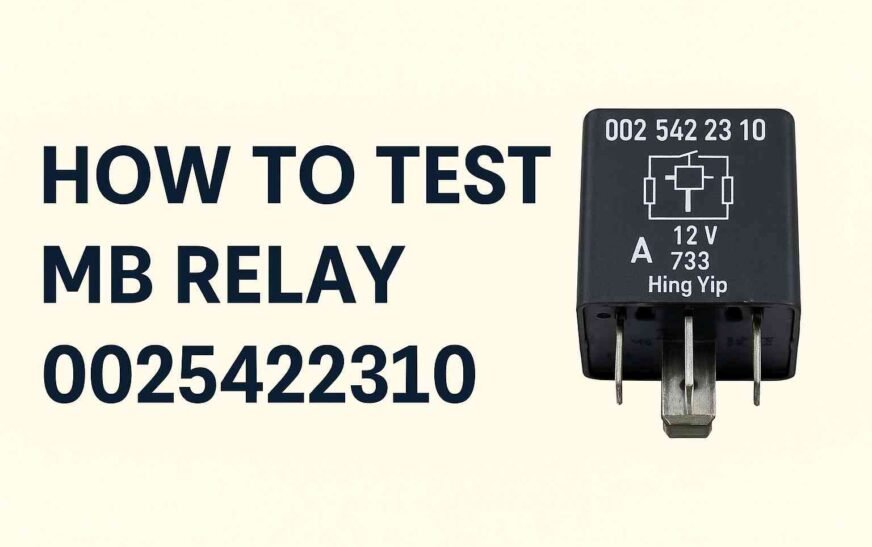When dealing with automotive electrical issues, understanding how to test MB relay 0025422310 can save you both time & money. This relay is commonly used in several Mercedes-Benz models & plays a vital role in regulating electrical flow to components like the fuel pump, starter motor, & cooling fan.
If this relay fails or malfunctions, it can cause engine cranking issues, intermittent starting, or even system shutdowns. That is why knowing how to test MB relay 0025422310 accurately is essential for both mechanics & car owners.
What Is MB Relay 0025422310?
Before diving into the process of testing, it is important to understand what MB relay 0025422310 is. This part is an OEM (Original Equipment Manufacturer) relay used in many Mercedes-Benz vehicles. It acts as an electrical switch that opens or closes the circuit depending on the control signal it receives. The relay ensures that high-current components receive the necessary voltage without overloading the main control system.
The number 0025422310 is the specific part number assigned to this relay. Knowing how to identify & test it properly can prevent misdiagnosis & unnecessary replacements.
Why Should You Know How to Test MB Relay 0025422310?
There are multiple reasons why testing this relay is important:
- It helps prevent complete vehicle breakdown.
- It allows accurate diagnosis of start-up or power-related failures.
- It saves costs by identifying the exact faulty component.
- It contributes to preventive maintenance, especially for older vehicles.
Whether you are a professional mechanic or a car enthusiast, learning how to test MB relay 0025422310 will enhance your ability to troubleshoot electrical problems efficiently.
Tools Required to Test MB Relay 0025422310
To perform a complete & accurate test, you will need the following tools:
- Digital multimeter (with continuity & voltage settings)
- A 12-volt power source (car battery or portable power supply)
- Jumper wires with insulated clips
- Wiring diagram for your specific vehicle model (recommended but optional)
- Safety gloves & goggles for protection
Always remember to disconnect the car battery before removing or testing any electrical components. This ensures your safety & prevents accidental damage.
Step-by-Step Instructions For How to Test MB Relay 0025422310
Below is a simple, safe, & accurate way to test MB relay 0025422310:
Identify the Relay Pins
Most MB relays, including 0025422310, have four or five pins labeled as 85, 86, 30, 87, & optionally 87a. These numbers indicate their function:
- Pin 85 & 86: Coil terminals (control side)
- Pin 30: Common terminal (power source)
- Pin 87: Normally open terminal (connected to load)
- Pin 87a: Normally closed (only in five-pin relays)
Refer to the relay’s diagram (usually printed on the casing) for confirmation.
Check Coil Continuity
Set your digital multimeter to resistance (Ohms) mode. Place the probes on pins 85 & 86. A normal resistance value should fall between 50 to 120 ohms. If the reading is zero or infinite, the coil is damaged, & the relay needs replacement.
This test checks whether the control side of the relay is working.
Test for Click Sound
Connect pin 85 to the negative terminal of your 12V power source. Connect pin 86 to the positive terminal. You should hear a clear “click” sound. This confirms that the electromagnetic coil is activating the switch inside.
If there is no click, it means the relay is not functioning correctly.
Check Continuity Between Pins 30 & 87
With the relay activated (i.e., power supplied to pins 85 & 86), place your multimeter in continuity mode. Now connect the probes to pins 30 & 87.
- If you hear a beep, the relay is working.
- If there is no sound or reading, the internal switch is not making contact & the relay is faulty.
Now disconnect the power & test again. Pins 30 & 87 should not have continuity when deactivated.
Optional Test for Five-Pin Relay
If your MB relay 0025422310 includes pin 87a, then test for continuity between pins 30 & 87a. You should get a reading when the relay is not energized. When power is supplied to the coil, that continuity should break.
This additional step is important if the relay is used for alternating current paths in the system.
Common Symptoms of a Faulty MB Relay 0025422310
Knowing how to test MB relay 0025422310 becomes even more useful when your vehicle displays these signs:
- The engine does not start or cranks slowly.
- The fuel pump does not activate when the ignition is on.
- Cooling fans or lights fail intermittently.
- The clicking sound is absent when trying to start the car.
- The relay becomes hot after short usage.
If you observe any of the above, testing the relay should be your first troubleshooting step.
Frequently Asked Questions
Can I test the relay without removing it from the car?
Yes, but only basic voltage checks. For full functionality tests, it is best to remove the relay.
What if the relay works intermittently?
That could be due to internal wear or loose connections. Replace the relay to avoid unpredictable behavior.
How often should I test my car relays?
Relays usually last many years, but testing them during regular maintenance is a smart preventive measure.
Is the MB relay 0025422310 used in all Mercedes models?
No. This part number is specific to certain models. Always confirm compatibility using your VIN or consult a parts catalog.
What is the replacement cost if the relay fails?
The relay itself is inexpensive, usually between $10 to $30. However, professional diagnostics may incur additional costs.
Final Thoughts
Understanding how to test MB relay 0025422310 can be incredibly helpful, especially if you are dealing with unexplained electrical problems in your Mercedes-Benz. This knowledge not only helps you make smarter repair decisions but also empowers you with confidence in troubleshooting.
If you are passionate about car electronics, learning the basics of relay testing will open the door to more advanced diagnostics & repair tasks.
For more guides like this, visit thepixwox, where expert insights & real-world tips are shared regularly.
By implementing the above step-by-step guide & testing tips, you can ensure your vehicle remains reliable, safe, & performance-ready.











